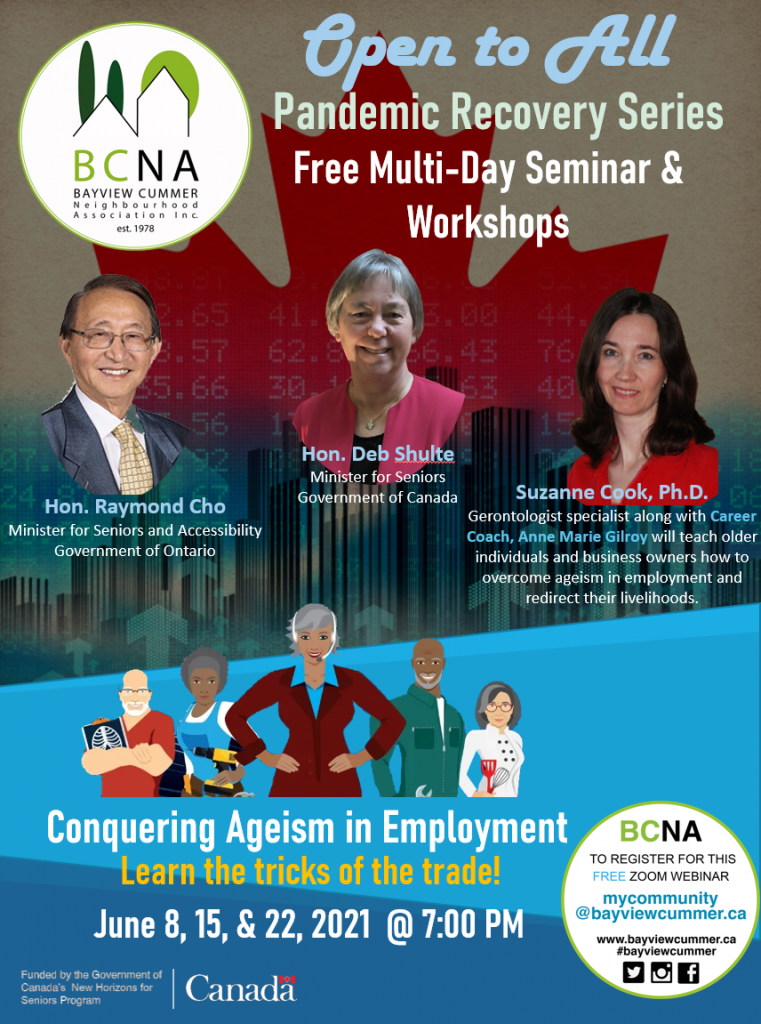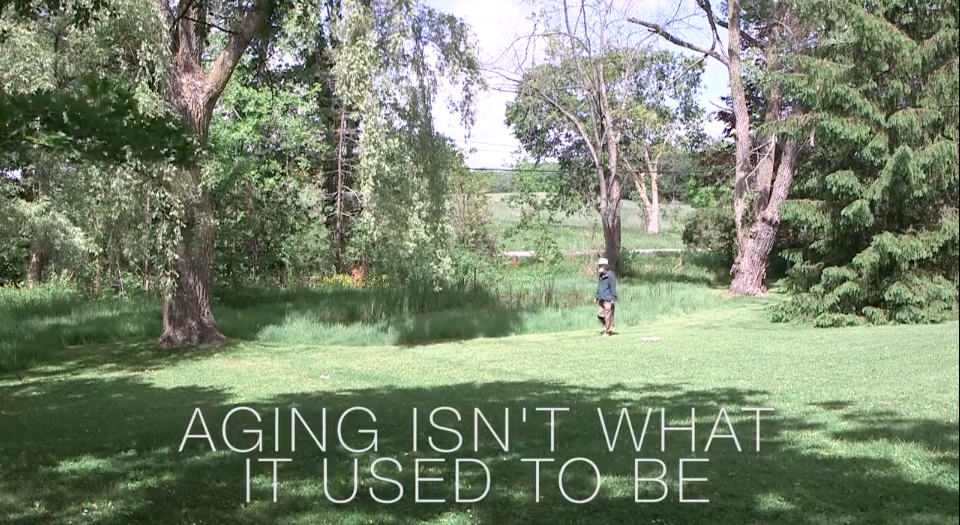Workshop Series
Posted by suzanne on Jun 7, 2021
It is exciting to share that a new workshop series is beginning June 8th, 2021. The series is entitled Pandemic Recovery Series Conquering Ageism in Employment and is hosted by the Bayview Cummer Neighbourhood Association (BCNA). It will assist mature workers who are looking for work and seeking a meaningful challenge.
Career Coach Ann Marie Gilroy and I are co-leading the series. It runs June 8th, 15th, and 22nd. It is free to attend.
Pre-register through this link: https://us02web.zoom.us/meeting/register/tZAsdemsrD8oHNfyC0GO44V5lklKB7mrRZTB
For more information visit: http://www.suzannecook.ca/workshops/

Category: Active Engagement, Aging, Aging Population, Aging Workforce, Business, Career, Economic Issues, Health and Wellness, Intergenerational, Lifelong Learning, Longevity, New Retirement, Redirection, Relationships, Social Participation, Social Policy, The Redirection Project, Vital Engagement, Work
 Post Tagged with Ageism, Aging Labour Force, Aging Population, Community, Documentary Film, Elderhood, Employment, Engagement, Experienced Workers, Finance and Economics, Income and Lifestyle, Intergenerational, Later Life Work, Mature Workforce, Meaningful-Later-Life-Work, Narrative, New Retirement, Older Workers, Redirection, Redirection Project, Skills, Storytelling, Well-being
Post Tagged with Ageism, Aging Labour Force, Aging Population, Community, Documentary Film, Elderhood, Employment, Engagement, Experienced Workers, Finance and Economics, Income and Lifestyle, Intergenerational, Later Life Work, Mature Workforce, Meaningful-Later-Life-Work, Narrative, New Retirement, Older Workers, Redirection, Redirection Project, Skills, Storytelling, Well-being Healthcare Workers
Posted by suzanne on Jan 4, 2021
During the pandemic, there have been on-going labour force shortages in healthcare with a large demand for nurses, personal support workers and physicians, as well as cleaning staff.
Staff shortages make it difficult to provide patient-centred care in hospitals and Long-term Care (LTC) homes. There are a variety of surveys and news reports on the crisis in healthcare staffing. One recent survey found that 95% of LTC homes reported a shortage in staff. In response to this survey, many healthcare professionals also stated that residents were not being properly fed and hydrated.
Unfortunately this fall, staff and residents in LTC are getting sick from Covid-19 just like they did in the spring of 2020. This creates more pressure on our healthcare system.
Healthcare staff are feeling the heavy burden. They are asking for assistance as Covid-19 infections increase.
Retirees are taking up the call. They want to help and are returning to work to provide care during Covid-19. Marg Miller is among them.
It’s time to develop formal return-to-work programs for mature workers who retire and have the knowledge and skills required to make a difference in the workplace. These professionals are making a difference during a time of great need.
Why isn’t there a provincial/territorial program to help them with the return-to-work?

Category: Aging, Aging Population, Aging Workforce, Health and Wellness, New Retirement, Work
 Post Tagged with Aging Population, Health, Later Life Work, Mature Workers, Mature Workforce, Older Workers, Retirement Trends
Post Tagged with Aging Population, Health, Later Life Work, Mature Workers, Mature Workforce, Older Workers, Retirement Trends Mature Workers and Technology
Posted by suzanne on Dec 27, 2020
Baby Boomers are embracing and using technology during the pandemic. Digital technology makes life easier and helps us manage daily activities better during Covid-19.
Not only are Boomers using technology. A new study indicates that Boomers have adopted innovative and time saving technologies such as virtual medical appointments and curbside pick up at a rapid pace compared to pre-Covid. These findings can help change perceptions about Boomers ignoring technological innovation being slow to accept new technology. The findings prove that Boomers are using technology and adapting their lives.
Innovation happens quickly and it is true that the digital technology available today was not available a couple of decades ago. Nevertheless, it is important to recognize that Baby Boomers are the generation who had to adapt to rapid technological change as computers entered the workplace. The reality is that technological advances were made across all industries impacting Boomers and their work.
This survey indicates that Boomers are adopting new technology faster than expected. Good on them for proving people wrong!

Category: Aging Population, Business, Lifelong Learning, Research
Aging Workforce and Policy
Posted by suzanne on Nov 28, 2020
I think it is timely to repost this blog from a few years ago. These key issues remain.
The population is aging in Canada as the baby boomer generation approaches and enters their later years. In a similar vein, the Canadian labour force is aging.
The aging population and labour force affect the Canadian economy. Policy makers, economists and government are concerned about how this will impact the economy.
Canada’s population growth is dependent upon the fertility rate, death rate and rate of immigration. Fertility rates have decreased over the decades as women have fewer children. Canadians are living longer. Immigration policy in Canada aims to bring more people into the country who can contribute to productivity and growth and compensation for the low fertility rate to keep the economy strong.
However, government, policy makers and economists do not fully recognize that older workers are eager to work and continue to work, in order to contribute to their communities. Older workers are skilled and experienced workers. They have communication, interpersonal and problem solving skills and have developed their ability to work with others. All of these skills are essential in the workplace today.
Organizational Level
As the populations ages and the workforce becomes older, all levels of society are impacted by demographic change. Importantly, this impacts organizations who are worried about a chronic labour shortage resulting from a rapidly aging population. Organizations have identified skill shortages in different roles across various industries. This is a top priority for business leaders.
Around the globe, other countries are innovating to address these concerns. These countries believe that the best way to adopt a successful aging strategy is to realize that aging is an opportunity.
One example is Japan, where policy makers have been steering the growing number of healthy 60- and 70 year olds away from retirement into work. These mature workers are taking on work roles and this makes them productive members of society. They hold jobs ”that otherwise would be impossible to fill as the population shrinks.”1
Furthermore, an entrepreneurial focus on the aging demographic, with products and services to support aging, ensures that aging is a benefit that broader society can reap.
Although consumer spending growth overall is weak in Japan, economists at UBS Securities there say they believe the expansion of the senior market could more than offset any declines that come from a shrinking population, at least for a time.2
For Japan, the way forward is clear. For more, visit Aging Gracefully in the Wall Street Journal.
Footnotes:
1 Schlesinger, J. M. & Martin, A. (2015). Entrepreneurs are exploring robotics and other innovations to unleash the potential of the elderly. Aging Gracefully: Graying Japan Tries To Embrace the Golden Years.
2 Ibid.
Longevity
Posted by suzanne on Nov 24, 2019
When we think about health in later life, much attention is on illness and chronic conditions. Research has often focused on illness and disease in later life, overemphasizing this as part of aging when it is possible for individuals to manage health issues and maintain a positive perspective on aging.
Older adults are healthier than in previous generations. In addition, life expectancy has increased significantly over the past 100 years. In the past, people would not live into their 60s, 70s or 80s. For example, my grandfather passed away just shy of his 100th birthday.
Many factors influence longevity. Research has discovered protective genes and environmental factors that influence life expectancy and longevity.
People continue to live with chronic health conditions such as diabetes. Individuals can manage different health issues while continuing to work, volunteer and provide caregiving to others. These activities are meaningful to individuals, families, communities and society in general. Fulfilling and satisfying activities provide broad health benefits such as belonging, social interaction and a sense of purpose. All of this contributes to mental health while keeping individuals connected to their communities.
More research should examine these protective health factors during later life rather than focusing solely on the health issues and risks.

Category: Active Engagement, Aging, Aging Population, Aging Workforce, Career, Family, Health and Wellness, Research, Social Policy
 Post Tagged with Aging, Aging Labour Force, Aging Population, Employment, Later Life Work, Meaningful-Later-Life-Work, Older Workers, Society, Well-being
Post Tagged with Aging, Aging Labour Force, Aging Population, Employment, Later Life Work, Meaningful-Later-Life-Work, Older Workers, Society, Well-being Seven Dimensions of Active Aging
Posted by suzanne on Apr 30, 2017
Thanks to our aging population, increasing numbers of people are reaching mid-life. They have made it to a certain age and realize they need step it up a bit to maintain their health. Some decide they need to work harder in order to become healthier.
In fact, people are paying more attention to the benefits of healthier, more active lifestyles across the lifespan. It is possible to improve health by working at it. The objective is for people to have not only increased lifespans, but increased healthspans. The approach of using the seven dimensions of active aging can help.
The seven dimensions of active aging is a model for health and wellness. I often share this model when people are interested in learning more about health, wellness and aging and want to understand how to live fuller, healthier lives. This model helps people to design a rich, well-rounded lifestyle and set goals for health and wellness.
The seven dimensions of active aging are the key areas to be aware of for healthy aging in order to improve the quality of life as individuals age. The seven dimensions of health and wellness are:
- Cognitive – brain health
- Physical – body fitness and sexuality
- Psychological – emotional health
- Social – relationships and social connections
- Spiritual – divine, psychic and transcendent
- Occupational – vocation, work and calling
- Environmental – the natural and build world
With this holistic approach to health and wellness, these dimensions are interconnected to create the whole person and their life. Being active and engaged helps individuals by stimulating at least one, and often, many of these dimensions. It is important to live a balanced lifestyle so that each of these dimensions are developed or stimulated. This is what individuals strive to achieve.
The Canadian population is aging and there are more older adults than previously. People are also living longer today than ever before. They want to live longer and healthier lives. They want to maintain or even improve their health and are paying more attention to health and wellness in order to achieve health-related goals and objectives. Healthspan is very important. The seven dimensions provide a broad perspective of the best ways to think about health and wellness. In addition, the dimensions indicate the areas for improvement in order to live healthier, more satisfying lives.

Category: Aging, Aging Population, Health and Wellness, Life and Living, Longevity, Relationships, Work
 Post Tagged with Aging, Aging Population, Education, Engagement, Health, Healthspan, Lifespan, Seven Dimensions
Post Tagged with Aging, Aging Population, Education, Engagement, Health, Healthspan, Lifespan, Seven Dimensions Freedom of R & R, or to Continue Working
Posted by suzanne on Apr 12, 2017
There is a realignment of work and retirement in society as the population ages. It is a growing trend. Older adults are continuing to work past traditional retirement age.
CBC’s The National followed a couple of Canadians as they reflected on their decision to keep working into their later years. They found work opportunities for their ‘next act’ that help generate an income and maintain their lifestyle. Furthermore, their work is personally fulfilling and meaningful to their community.
Benefits go beyond the paycheque; working keeps people active and engaged. It was also nice to hear another perspective on the benefits of hiring mature workers.
I coined the term redirection to refer to the new stage of career as people transition into new pursuits and occupation to stay engaged and continue to work. Redirection is an alternative to retirement. It is an exciting time of life. New possibilities are investigated and explored. Older adults discover that their skills and competencies are transferable. My new documentary film explores five people’s experiences with redirection.
CBC News discusses the trend towards delayed retirement. Provinces like Nova Scotia and New Brunswick are already rethinking and implementing policy to address this new trend.
It is time to rethink government policy to consider the ways people are and can work longer and what this means for social structures and institutions in Canada.

Category: Active Engagement, Aging Population, Aging Workforce, Career, Economic Issues, Family, Health and Wellness, Intergenerational, Life and Living, Longevity, New Retirement, Relationships, Social Policy, The Redirection Project, Work
 Post Tagged with Aging Population, Business and Seniors, Documentary Film, Employment, Experienced Workers, Finance and Economics, Health, Income and Lifestyle, Later Life Work, Mature Workers, Mature Workforce, Meaningful-Later-Life-Work, New Retirement, Redirection Project, Retirement Trends, Skills, The Redirection Project
Post Tagged with Aging Population, Business and Seniors, Documentary Film, Employment, Experienced Workers, Finance and Economics, Health, Income and Lifestyle, Later Life Work, Mature Workers, Mature Workforce, Meaningful-Later-Life-Work, New Retirement, Redirection Project, Retirement Trends, Skills, The Redirection Project Older Workforce, Aging Consumers
Posted by suzanne on Feb 10, 2017
The population is aging in Canada as the baby boomer generation approaches and enters their later years. In a similar vein, the Canadian labour force is aging.
The aging population and labour force affect the Canadian economy. Policy makers, economists and government are concerned about how this will impact the economy.
Canada’s population growth is dependent upon the fertility rate, death rate and rate of immigration. Fertility rates have decreased over the decades as women have fewer children. Canadians are living longer. Immigration policy in Canada aims to bring more people into the country who can contribute to productivity and growth and compensation for the low fertility rate to keep the economy strong.
However, government, policy makers and economists do not fully recognize that older workers are eager to work and continue to work, in order to contribute to their communities. Older workers are skilled and experienced workers. They have communication, interpersonal and problem solving skills and have developed their ability to work with others. All of these skills are essential in the workplace today.
Organizational Level
As the populations ages and the workforce becomes older, all levels of society are impacted by demographic change. Importantly, this impacts organizations who are worried about a chronic labour shortage resulting from a rapidly aging population. Organizations have identified skill shortages in different roles across various industries. This is a top priority for business leaders.
Around the globe, other countries are innovating to address these concerns. These countries believe that the best way to adopt a successful aging strategy is to realize that aging is an opportunity.
One example is Japan, where policy makers have been steering the growing number of healthy 60- and 70 year olds away from retirement into work. These mature workers are taking on work roles and this makes them productive members of society. They hold jobs ”that otherwise would be impossible to fill as the population shrinks.” 1
Furthermore, an entrepreneurial focus on the aging demographic, with products and services to support aging, ensures that aging is a benefit that broader society can reap.
Although consumer spending growth overall is weak in Japan, economists at UBS Securities there say they believe the expansion of the senior market could more than offset any declines that come from a shrinking population, at least for a time.2
For Japan, the way forward is clear. For more, visit Aging Gracefully in the Wall Street Journal.
Footnotes:
1,2Schlesinger, J. M. & Martin, A. (2015). Entrepreneurs are exploring robotics and other innovations to unleash the potential of the elderly. Aging Gracefully: Graying Japan Tries To Embrace the Golden Years.

Category: Aging, Aging Population, Aging Workforce, Business, Economic Issues, Longevity, Services for Seniors, Social Policy, Work
 Post Tagged with Aging Labour Force, Aging Population, Employment, Finance and Economics, Mature Workers, Mature Workforce
Post Tagged with Aging Labour Force, Aging Population, Employment, Finance and Economics, Mature Workers, Mature Workforce Documentary on Later Life Career
Posted by suzanne on Oct 17, 2016
There is a shift surrounding later life with the extension of working lives. In fact, both work and aging have changed a lot compared to earlier times. Specifically, the nature of work has changed, people are working longer, and people are aging differently.
People are living longer than in previous generations. They are thinking differently about their work and occupation. Work fills various objectives for individuals.
The documentary film “Redirection: Movers, Shakers and Shifters” shows the experiences of five people age 50 and older as they moved into second or third careers. The film is being released through feature presentations. The one minute trailer is available for viewing.
What will later life work look like for you? What’s next?

Category: Aging, Aging Population, Career, The Redirection Project, Work
Work and Aging: Symposia
Posted by suzanne on Aug 29, 2016
Work and occupation are important across the life course. It is a great thrill to share the most recent research on work and aging at the upcoming CAG annual scientific and educational meeting to be held in Montreal, Quebec. At this year’s conference, I am chairing two Symposia on work and aging. I have invited some esteemed scholars to present their work. The Symposia are to be held on Saturday, October 22nd, 2016.
During the first Symposium, I will be discussing the Redirection Project. During the second Symposium, I am sharing the documentary film Redirection: Movers, Shakers and Shifters which helps bring key issues from my Redirection Project to a broader audience.
Symposium I: Policy Imperatives for Later Life Work
Symposium II: Movers, Shakers and Shifters: Later Life Career Redirection
It is very exciting to have scholars presenting on issues surrounding work and aging and gratifying to see this much attention devoted to work and occupation as people age at CAG. As a broad gerontological topic, work and aging is particularly relevant and timely as the large cohort of baby boomers approach later life and gain their own perspective on being mature and experienced workers.

Category: Aging, Aging Population, Aging Workforce, Career, Economic Issues, Longevity, Research, The Redirection Project, Work










